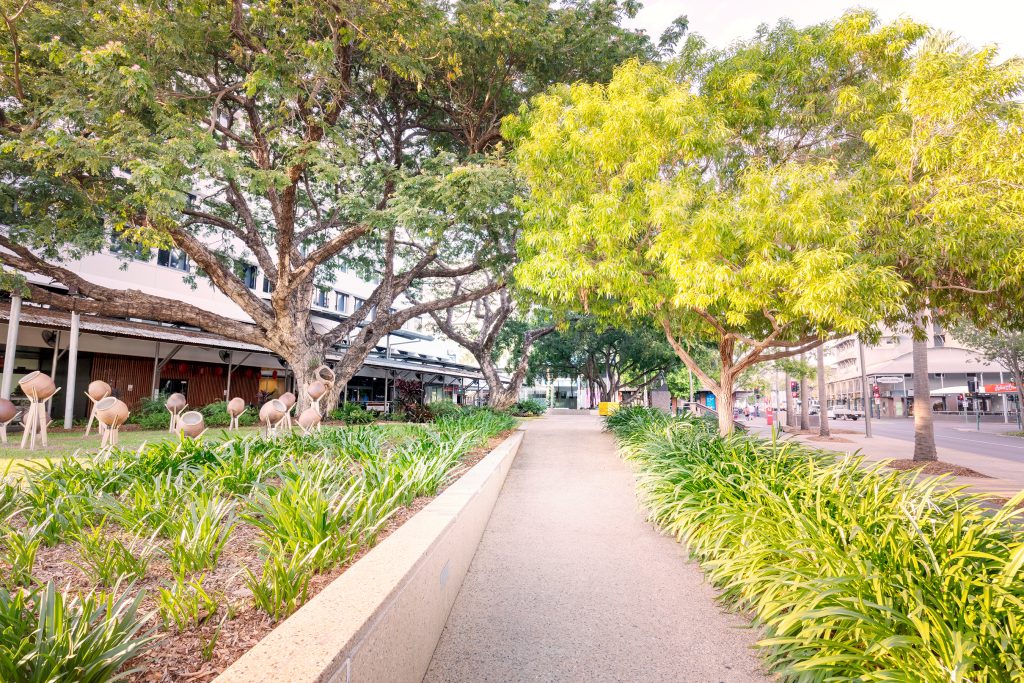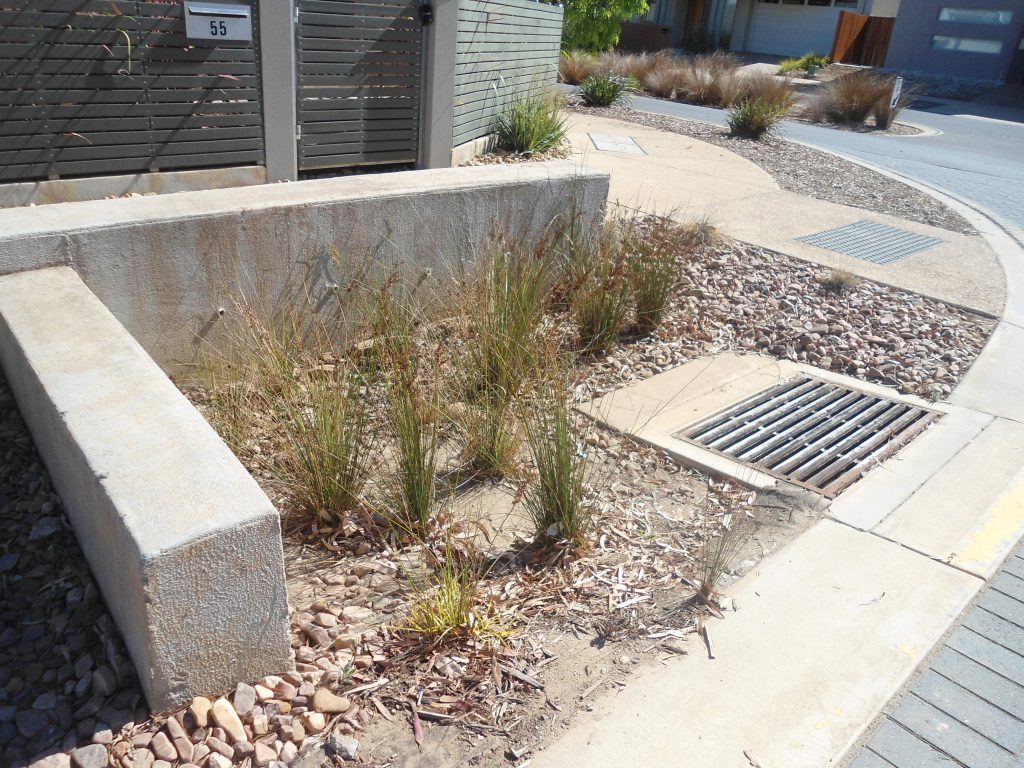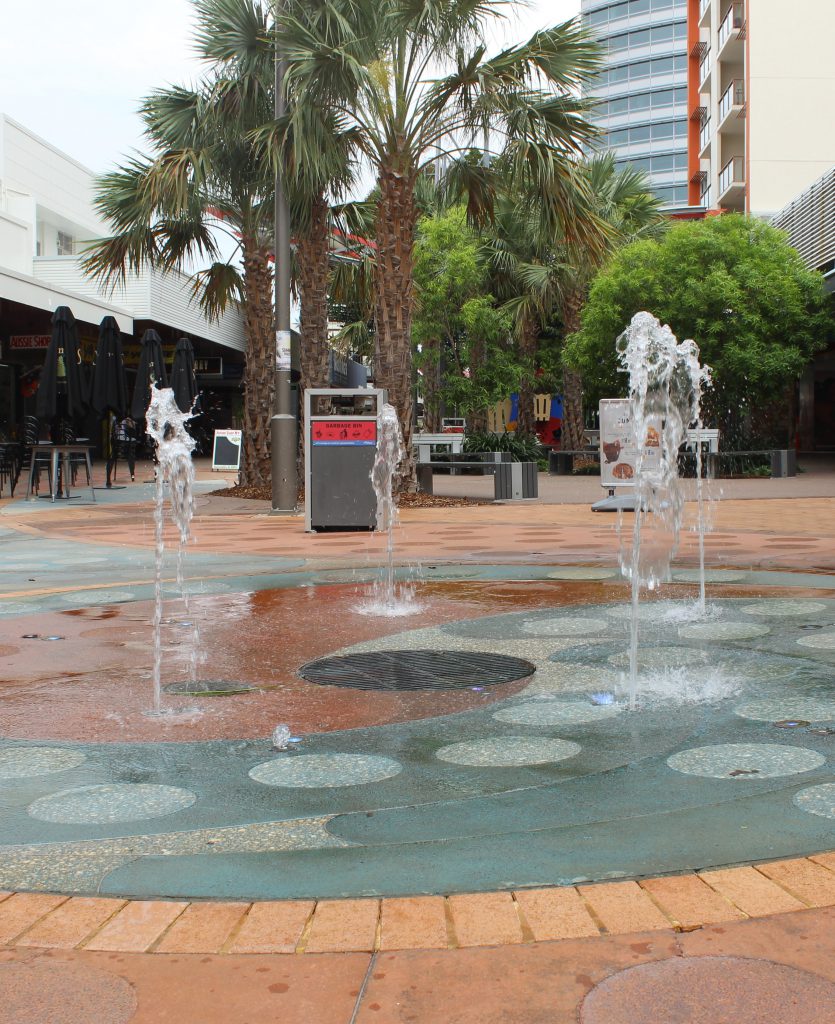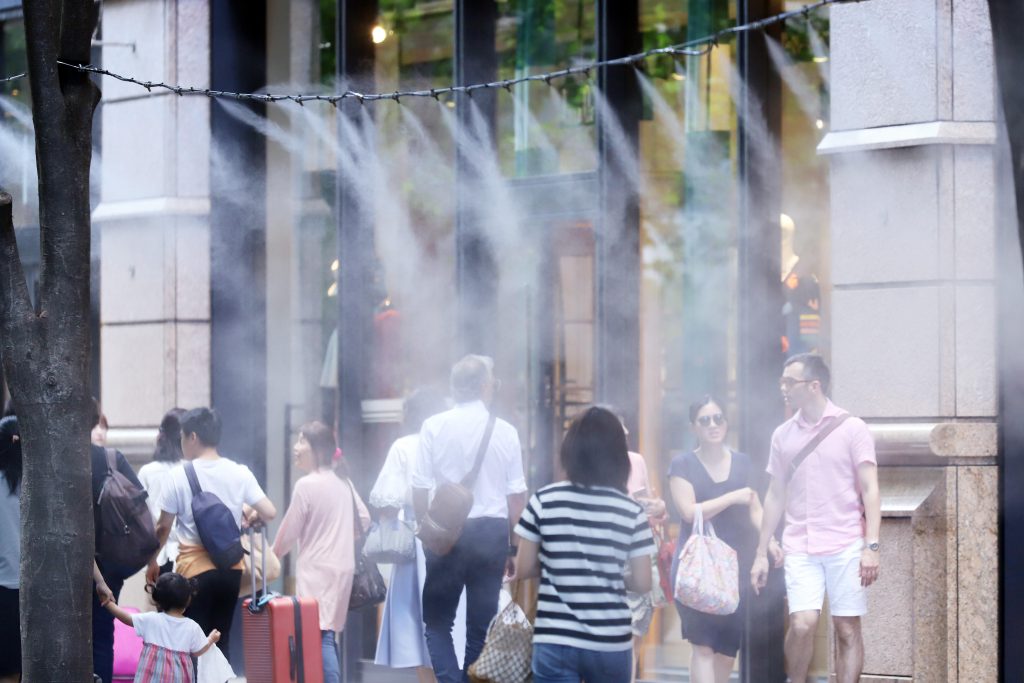Add
wateR
Water sensitive urban design
Water sensitive urban design (WSUD) seeks an approach to urban planning that is sensitive to the natural water cycle and ecological processes. This can help with managing flood risk, improving local water quality, while also reducing urban temperatures through evapotranspiration and surface cooling1-4. WSUD approaches will depend on the specific constraints and opportunities of each development, but can include rainwater harvesting, rain gardens, bio-retention systems, green roofs, pervious pavements, wastewater recycling, gross pollutant traps, swales, constructed wetlands and demand management5. WSUD approaches can provide integrated options for reducing heat in urban environments6.

Opportunities in Darwin

Integrating water sensitive approaches in the design of greenspace
WSUD approaches such as raingardens, swales and pervious pavements can be integrated in the design of greenspace that help to create cool and green sanctuaries from the heat in the city. WSUD approaches can help to retain water in the landscape and allow for the retention of natural flow-paths and infiltration of stormwater runoff. WSUD features can help support greening strategies, such as the use of raingardens with tree pits, which support healthy vegetation that can reduce temperatures in the city through enhanced evapotranspiration and surface cooling6.

Water features
Bodies of water in urban areas, such as constructed wetlands or ponds, can potentially combat high temperatures in urban environments. Water play areas in Darwin, such as the Smith Street Mall Fountains or the interactive water playground at the Casuarina Square Shopping Centre, assist in cooling larger plazas and squares and provide a space for families to cool down while children play.
Bodies of waters such as ponds and constructed wetlands can provide cooling benefits in urban areas, particularly downwind from the water body. Water bodies, particularly larger water bodies, provide a sink to absorb heat from solar radiation, while increased surface area will increase evaporation and local cooling7. However, water bodies can increase local absolute humidity, which can impact on outdoor thermal comfort8. In Darwin, this increase in humidity may decrease thermal comfort where cooling breezes are absent, especially during the build-up and wet season. Water bodies, such as constructed wetlands in urban areas, can provide optimal conditions for mosquitoes, presenting a public health risk due to mosquito-borne diseases9. Best practice management of this risk includes monitoring of mosquito population and establishing aquatic vegetation that encourages predator access to mosquito larvae10.

Water Misting
A water spraying system is an energy-efficient, economical and environmentally friendly method for improving thermal comfort in urban environments and is an effective local countermeasure to provide relief on hot days. Spray misting already exists in many restaurants at the Darwin Waterfront, allowing diners a chance to sit outside to enjoy the view while staying cool.
Misting cooling systems can also be used to cool people in street canyon, while the cooling benefit is greatest for people located directly under the mist people in the middle of the street may feel the cooling effect because of the dispersion and accumulation of the cooled air. Research suggests that under drier conditions the water spray systems will have higher cooling performance, which may limit the cooling potential for pedestrians during the build-up and wet season. The use of misting fans needs to manage the potential health risks. In Singapore it was found that increased use of misting fans, when poorly maintained, could provide a public health risk due to Legionella, which if inhaled can result in Legionnaires’ disease11.
Key points to consider
- Water sensitive approaches can be integrated in the design of greenspace that helps to retain water in the landscape and contribute to cooling in the city.
- Water bodies can help improve outdoor thermal comfort by providing a heat sink and aiding evaporative cooling, but increase humidity which might limit cooling potential in Darwin during build-up and wet.
- Increased uptake of WSUD approaches in Darwin is likely to require more detailed understanding of the performance and life-cycle costs of different WSUD approaches in the wet-dry tropics
- There is the need to manage health risks associated with introducing water into the urban environment through adequate maintenance
Further information
References
- Berland, A.; Shiflett, S. A.; Shuster, W. D.; Garmestani, A. S.; Goddard, H. C.; Herrmann, D. L.; Hopton, M. E., The role of trees in urban stormwater management. Landscape and Urban Planning 2017, 162, 167-177.
- Masi, F.; Rizzo, A.; Regelsberger, M., The role of constructed wetlands in a new circular economy, resource oriented, and ecosystem services paradigm. Journal of Environmental Management 2018, 216, 275-284.
- Fletcher, T. D.; Shuster, W.; Hunt, W. F.; Ashley, R.; Butler, D.; Arthur, S.; Trowsdale, S.; Barraud, S.; Semadeni-Davies, A.; Bertrand-Krajewski, J.-L.; Mikkelsen, P. S.; Rivard, G.; Uhl, M.; Dagenais, D.; Viklander, M., SUDS, LID, BMPs, WSUD and more – The evolution and application of terminology surrounding urban drainage. Urban Water Journal 2015, 12, (7), 525-542.
- Van Roon, M. R.; Rigold, T., Urban form and WSUD in Auckland residential catchments determine stream ecosystem condition. In Urban Water: Planning and Technologies for Sustainable Management’ 9th International Conference of Novatech, , Lyon, France, 2016.
- Cook, S.; van Roon, M.; Ehrenfried, L.; LaGro, J.; Yu, Q., Chapter 27 – WSUD “Best in Class”—Case Studies From Australia, New Zealand, United States, Europe, and Asia. In Approaches to Water Sensitive Urban Design, Sharma, A. K.; Gardner, T.; Begbie, D., Eds. Woodhead Publishing: 2019; pp 561-585.
- Coutts, A. M.; Tapper, N. J.; Beringer, J.; Loughnan, M.; Demuzere, M., Watering our cities: The capacity for Water Sensitive Urban Design to support urban cooling and improve human thermal comfort in the Australian context. Progress in Physical Geography 2013, 37, (1), 2-28.
- Cooling Singapore Strategies for Cooling Singapore; Singapore, 2017.
- Syafii, N. I.; Ichinose, M.; Kumakura, E.; Jusuf, S. K.; Chigusa, K.; Wong, N. H., Thermal environment assessment around bodies of water in urban canyons: A scale model study. Sustainable Cities and Society 2017, 34, 79-89.
- Crocker, W.; Maute, K.; Webb, C.; French, K., Mosquito assemblages associated with urban water bodies; implications for pest and public health threats. Landscape and Urban Planning 2017, 162, 115-125.
- Hanford, J. K.; Webb, C. E.; Hochuli, D. F., Management of urban wetlands for conservation can reduce aquatic biodiversity and increase mosquito risk. Journal of Applied Ecology 2020, 57, (4), 794-805.
- Lim, Y.; Kek, Y. R.; Lim, P.; Yap, H.; Goh, T. V.; Ng, L., Environmental surveillance and molecular characterization of Legionella in tropical Singapore. Trop Biomed 2011, 28, (1), 149-159.
ACKNOWLEDGEMENT
Your Tropical City acknowledge the Larrakia people as the Traditional Owners of the Darwin region and pay our respects to Larrakia elders past and present. We are committed to a positive future for the Aboriginal community.
564 Vanderlin Drive,
Berrimah NT 0828
(08) 8944 8436
hello@yourtropicalcity.com.au
PARTNER
ACKNOWLEDGEMENT
Your Tropical City acknowledge the Larrakia people as the Traditional Owners of the Darwin region and pay our respects to Larrakia elders past and present. We are committed to a positive future for the Aboriginal community.
CONTACT
564 Vanderlin Drive,
Berrimah NT 0828
(08) 8944 8436
hello@yourtropicalcity.com.au
PARTNER